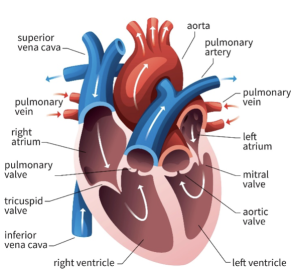CONDITIONS
What is Human Heart?
The human heart is a powerful machine that pumps blood throughout our body. It’s a fist-sized muscle located in the middle of our chest, slightly to the left. The heart beats around 75 times per minute, pumping approximately 2000 gallons of blood every day. This blood carries oxygen and nutrients to our organs and tissues while removing waste materials. The heart pumps poorly oxygenated blood to the lungs where it undergoes a process of oxygenation and gets rid of carbon dioxide, a waste product. The heart, blood, and blood vessels together form the circulatory system that keeps everything working properly.

Facts
- On average, the heart beats about 100,000 times a day, i.e., around 3 billion beats in a lifetime
- The average male heart weighs 280 to 340 grams, while the female heart weighs 230 to 280 grams
- Adult heart rate ranges from 60 to 100 beats per minute, while a newborn’s heart beats faster at 90 to 160 beats per minute
Structure of the heart
The heart has four chambers: the right and left atria (upper chambers) and the right and left ventricles (lower chambers). These chambers are separated by walls called the atrial and ventricular septum.
Blood vessels, arteries, and veins carry blood to and from the heart. Arteries carry blood away from the heart, while veins carry blood back to the heart. Major veins include the superior vena cava and inferior vena cava, while the pulmonary artery and aorta are the primary arteries.
Heart valves: Heart valves act as one-way doors between heart chambers, ensuring blood flows in the right direction. The four main valves are:
Tricuspid valve: Located between the right atrium and right ventricle, it allows blood to flow from the atrium to the ventricle.
Mitral valve: Found between the left atrium and left ventricle, it permits blood passage from the atrium to the ventricle.
Pulmonary valve: Opens when the right ventricle contracts, allowing deoxygenated blood to move into the pulmonary arteries and toward the lungs for oxygenation.
Aortic valve: Opens when the left ventricle contracts, enabling oxygenated blood to flow into the aorta, the main artery supplying blood to the body.
Functions
- The heart’s primary function is to circulate blood, delivering oxygen and nutrients while removing waste products.
- It regulates heart rate through electrical impulses, ensuring the heart beats at an appropriate rate.
- Additionally, the heart helps maintain blood pressure by pumping blood with sufficient force to overcome resistance in blood vessels, facilitating proper oxygen and nutrient delivery.









